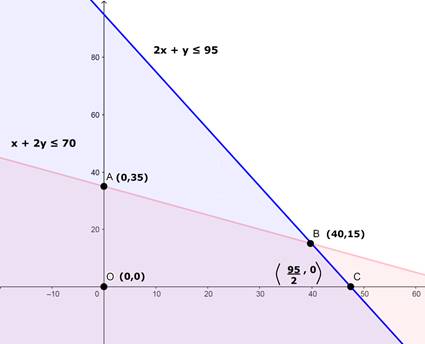The point at which the maximum value of x + y, subject to the constraints x + 2y ≤ 70, 2x + y ≤ 95, x, y ≥ 0 is obtained, is
Given objective function is Z = x + y
Constraints are:
x + 2y ≤ 70
2x + y ≤ 95
x, y ≥ 0
Let us consider these constraints as equations for a while, then we will have,
x + 2y = 70 ----- (1)
2x + y = 95 ----- (2)
Now, graph the equations, by transforming the equations to intercept form of line.
Equation (1) dividing throughout by 70
![]()
![]()
The line x + 2y = 70 can be plot in the graph as a line passing through the points, (70,0) and (0,35) as 70 and 35 are the intercepts of the line on the x-axis and y-axis respectively.
Similarly equation (2) can be divided 95 to get
![]()

The line 2x + y = 95 can be plot in the graph as a line passing through the points, (![]() ,0) and (0,95) as
,0) and (0,95) as ![]() and 95 are the intercepts of the line on the x-axis and y-axis respectively.
and 95 are the intercepts of the line on the x-axis and y-axis respectively.
By considering the constraints x , y ≥ 0, this clearly shows that the region can only be in the 1st quadrant.
The graph of the inequations will look like,

The points OABC is the feasible region of the LPP.
Now from the points O, A ,B and C the vertices of the polygon formed by the constraints, one of the points will provide the maximum solution to the function Z = x + y
Now checking the points, O,A,B and C by substituting in Z = x + y.

From the above values, it is clear that Z maximized at point B( 40,15).
Hence the answer is option D.